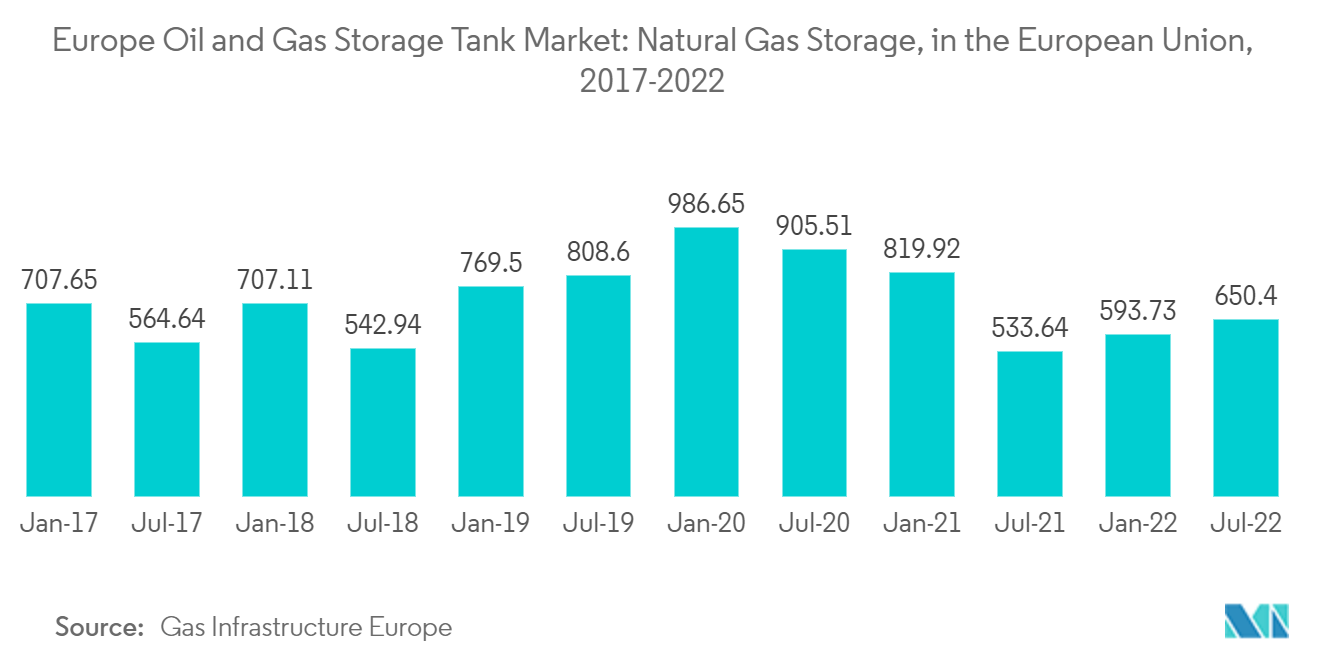Market Trends of Europe Oil and Gas Storage Tank Industry
This section covers the major market trends shaping the Europe Oil & Gas Storage Tank Market according to our research experts:
Midstream to Witness Significant Growth
Europe is home to some of the oldest oil-producing countries in the world. The region is also one of the largest offshore oil and gas markets worldwide. Norway, the United Kingdom, and Russia are some of the major countries in the region's oil and gas industry.
The midstream sector pertains to the transport and storage of crude oil and natural gas extracted. It includes infrastructure such as crude oil and natural gas pipelines, gas treatment plants, natural gas liquefaction plants, and liquefied gas and regasification storage. The growing oil and gas production and aging infrastructure drive the demand for new midstream infrastructure, increasing the demand for storage tanks in Europe.
As of July 2022, the European Union's gas storage volume amounted to 650.4 terawatt-hours (TWh), accounting for approximately 89.02% of its capacity. The quarterly gas storage volume in the European Union reached a decade-peak in January 2020, with nearly 986.65 TWh of natural gas in supply.
In May 2022, Uniper signed an agreement with German authorities to build the country's first liquefied natural gas (LNG) terminal to enable the country to reduce its reliance on Russian gas. The federal government also signed a letter of intent to charter four floating storage and regasification units (FSRUs) to import gas.
In May 2022, Centrica PLC acquired the rights to restart Britain's largest natural gas storage site as Europe's energy crisis intensifies. The award of a license allows COUK (Centrica offshore UK) to seek further regulatory approvals before gas storage operations can commence.
Therefore, based on the above-mentioned factors, the midstream segment is expected to witness significant demand in the European oil and gas storage tank market during the forecast period.

Germany to Witness Significant Growth
Growing oil and gas consumption in Germany has resulted in the complete utilization of storage and pipeline capacities. New oil storage terminals have been planned in the country to cater to the demand from domestic end users.
As of January 2022, Germany had 22.6 million tons of oil equivalent in strategic crude oil reserves. This was a slight decrease compared to the end of March 2021. According to the legal framework in Germany, the government aims to ensure a certain level of crude oil reserves to be able to combat future shortages, at least temporarily.
In July 2022, Germany and Austria signed a deal to accelerate the filling of gas storage facilities. With the signing of a bilateral solidarity agreement, the two countries agreed to cooperate on the use of liquefied natural gas (LNG) infrastructure and storage filling.
In September 2022, Germany's natural gas storage facilities reached more than 85%, showing steady progress despite a drastic reduction in deliveries from Russia amid the war in Ukraine. The government's target to reach 85% storage capacity by October was achieved at the beginning of September.
Therefore, based on the above-mentioned factors, Germany is expected to witness significant growth in the European oil and gas storage tank market during the forecast period.


